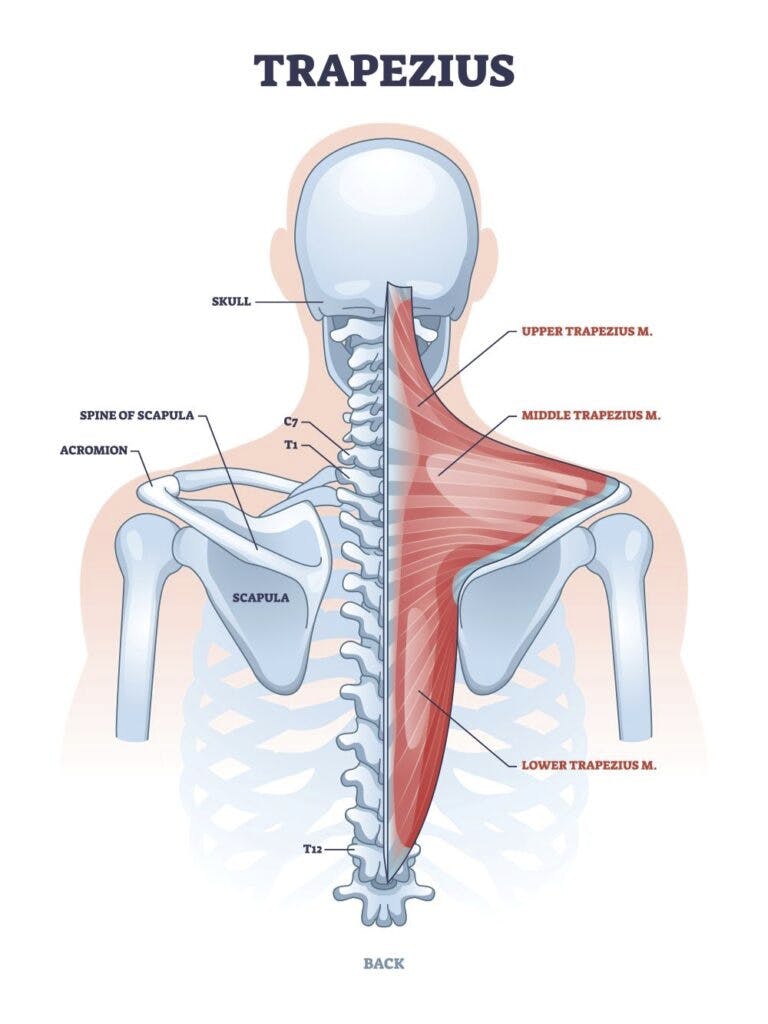Your typical strength training program probably hits all the big muscles in your arms and trunk. However, most people neglect several crucial muscles in their shoulder and upper back. Bad idea! If you want your arm to properly function overhead, target your lower trapezius muscle in your strength training program. This article highlights 3 of the best lower trapezius exercises.
The lower trapezius muscle plays an important role in moving and positioning your shoulder blade (scapula) during overhead activities. It spans from your lower 6 thoracic vertebrae to the upper portion of your shoulder blade. Your lower trapezius, upper trapezius, and serratus anterior work together to upwardly rotate your scapula. This is important to position your arm during overhead activities like the cocking phase of throwing a baseball.
Role of the Lower Trapezius in Sport

Poor upper back posture places your lower trapezius at a disadvantage in fulfilling its role as a scapular stabilizer. Therefore, be sure to also include thoracic spine extension exercises in your program.
Many overhead athletes with shoulder pain have delayed lower trapezius activation. Also, weakness leads to upper extremity injuries in baseball, swimming, and tennis.
Exercises with your arms below shoulder level elicit very little lower trapezius activity. Movements that facilitate scapular upward rotation achieve better activation. The lower fibers align at an approximate 135-degree angle from the spine. This corresponds to the 10:00 and 2:00 positions on a clock. Exercises such as the wall slide, prone trapezius raise, and shoulder external rotation in 90 degrees of abduction position your scapula for optimal lower trapezius activation.
Prone 1-Arm Lower Trapezius Raise
Lie face down with one arm over the side of a table or bench. Keep your neck in a relaxed neutral position resting on your other forearm. Position your thumb up, arm straight, and elbow slightly bent. Then lift your arm toward the ceiling at a 45-degree angle from your head (the 10:00 and 2:00 positions of a clock). This position is aligned with the muscle fibers of your lower trapezius.
Be careful to avoid shrugging your entire shoulder as you raise your arm. Instead, think about tilting your shoulder blade backward as you raise your arm. Pause at the top of the movement before returning to the start position in a controlled manner. We recommend low loads and high reps (2 to 3 sets of 12 to 20 reps).
Prone External Rotation in 90 Degrees of Abduction
Lie face down with one arm over the side of a table or bench supported on a small towel roll. Keep your neck in a relaxed neutral position resting on your other forearm. Rotate your hand up towards the sky in a slow and controlled manner.
Avoid shrugging your entire shoulder as you perform the exercise. Pause at the top of the movement before returning to the start position. We recommend low loads and high repetitions (2 to 3 sets of 12 to 20 reps).
Wall Slides at 135 Degrees with Lift Off
Stand to face a wall with one foot slightly ahead of the other. Place both forearms against the wall starting just below shoulder level. Initiate the movement by sliding your forearms toward the ceiling at a 45-degree angle from your head (the 10:00 and 2:00 positions of a clock). Once the elbows are fully extended, slightly lift your hands and arms away from the wall.
Avoid arching your lower back as you lift away. Instead, think about tilting your shoulder blades backward as you lift. Pause at the top of the movement before returning to the start position in a controlled manner. Perform 2 to 3 sets of 10 to 20 repetitions.
Do You Need Help Getting Started with Lower Trapezius Exercises?
The lower trapezius muscle is often ignored by people who regularly engage in strength training. Poor timing or weakness of this muscle leads to poor movement and pain during overhead activity. Specific exercises targeting your lower trapezius should be included as part of your warm-up routine or regular program to optimize shoulder health.
Your physical therapist will help you develop the best exercise program for your needs and goals. The doctors or physical therapy at BSR Physical Therapy in Manahawkin and Barnegat have been helping people move without pain since 2007. Contact us to schedule your initial evaluation.


